Tag: mike dolce

DOLCE REVEALS WHAT SEPARATES HIM FROM THE REST
DOLCE REVEALS WHAT SEPARATES HIM FROM THE REST
by Stephanie Daniels, Crooklyn’s Corner
Mike Dolce is a name that pops up frequently in MMA. Whether it be from fighting professionally, guiding the top athletes to healthier lifestyles or writing books, more and more people are recognizing him, and his contributions to the sport. TapouT Radio conducted a recent interview with the nutrition guru, and was able to extract the recipe for success, the Dolce way.
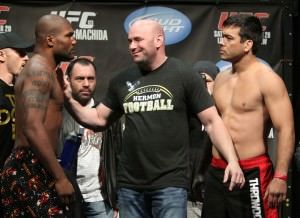
“What people don’t realize, is that I’ve been working with elite level athletes for over 20 years. I currently work with the best athletes in the world, on a daily basis. My guys are in the top 3 or top 5 in their weight classes, in the world. My skills, my techniques, my philosophies, my education, and my experience is constantly being refined among the world’s most elite. When you have a relationship with somebody, you experience and you absorb parts of that relationship. I deal with elite athletes, that are on elite teams, with elite coaches, coaching systems and techniques, and they themselves have decades of elite training behind them. I am constantly on the forefront of the sport. I can say that with the utmost confidence. I know what I do in a given day, and I hear when world champions point at me and say the amazing things that they say about me, and how revolutionary my techniques are. That’s why people know the Dolce Diet. That’s what separates me from the rest. Now there’s people that spend a lot of time, sitting in school and getting degrees and all those great things, and that’s nice, but that’s just a very small piece. The experience of being in the trenches, of course, is the most important thing, you know, what actually does work, in a real world setting. Then I take that information, and I add it to the next elite athlete. I have constant petri dishes. I have my experiments, all over the world. My athletes are at the top of the heap, and I’m a part of their performance.”
With a new book, websites, family and a full schedule, working with the likes of Chael Sonnen, Thiago Alves, Chris Leben, Jay Heiron, Jake Ellenberger, and Keith Jardine, one has to wonder if Mike has a clone or two stashed in a closet. When asked how he manages to keep all theses components in balance, and if he might be taking on too much, he stated,

“Am I spreading myself too thin? Absolutely not. I’m actually very efficient in blocking out my time. When I deal with an athlete, I deal with them in very specific terms, so each one I work with, retains me for very specific features or responsibilities, and I’m able to professionally maintain all my relationships and fulfill all my duties to them. The area that takes the biggest hit, is my home life, but I’m blessed with a wonderful family that supports me, and allows me time to focus on my work with the athletes, and getting these guys in the best shape of their life. I’m pretty close to the end of my ability to bring on new athletes, though. I’m a loyal guy, and I’m going to stick with the guys I currently work with, with very rare exceptions.”
Mike’s new book, Living Lean is releasing in September, via his website. He gave a little insight on it, saying,
“It’s kind of a beginner’s story about myself, getting into the industry and to the business. There is a little bit of a story to it. The story is meant to coach and to teach very specific principles that I want you to walk away with. I get into nutrition, and I show you how you can eat as an athlete, a vegan, a gluten free practitioner, or if you’re just concerned with health and wellness. Those four different nutritional types are what I discuss. I also get into exercise programs, for general wellness or professional athletes. Truly, it’s to build a profile of very lean, healthy, vibrant and energized lifestyles.”
Story written for CrooklynsCorner.com
KEITH JARDINE BRINGS ON MIKE DOLCE FOR MOVE TO MIDDLEWEIGHT

“Keith Jardine Returns to Strikeforce in Dec; Brings on Mike Dolce for Move to Middleweight”
By Damon Martin
‘The Dean of Mean’ Keith Jardine will be back in action this December in the Strikeforce cage, and he’ll have some extra help as he makes his move to the middleweight division.
Jardine first announced that he expected to fight on the December card via his website.
“It looks like I’ll be fighting again for Strikeforce in December,” Jardine wrote. “It’s a little ways off, but it feels good to have a date.”
The card Jardine will appear on will also likely be the landing destination for the upcoming lightweight title fight between Strikeforce champion Gilbert Melendez and challenger Jorge Masvidal.
While the fight for the former ‘Ultimate Fighter’ 2 competitor is still a few months off, Jardine has been promising a move to 185lbs ever since his last fight in Strikeforce. In that bout, Jardine battled to a draw with former champion Gegard Mousasi.
Following the match-up Jardine announced his intentions to drop down to middleweight after a long career that was spent at both heavyweight and light heavyweight.
To ensure that he has the easiest weight cut possible, Jardine has employed the services of famed MMA nutritionist MIKE DOLCE to lead the charge.
Dolce has worked with several high profile fighters either in an initial weight cut process, or those who have had trouble making weight in the past. In all instances however Dolce’s reputation has made him one of the most sought after trainers in the business.
Jardine told MMAWeekly.com in early August that he would love his next fight to be against former Strikeforce middleweight champion Cung Le, but any big name would suffice because his ultimate goal is to get a shot at the 185lb title.
“I’ve fought so many guys that have had the belt, but never fought for the belt myself,” Jardine said. “I’ve probably fought five world champions before, and it’s about time I fight for the title.”
News on who Jardine might face in December has not been released yet, but sources have indicated that the card is still being put together by Strikeforce matchmaker Sean Shelby.
Follow Damon Martin on Twitter @DamonMartin
MATT MITRIONE ADDS MIKE DOLCE TO CAMP FOR UFC 137 – MMAweekly.com

Matt Mitrione Adds Mike Dolce to Camp for UFC 137 Preparation To Face Kongo
Posted on August 25, 2011 by Damon Martin
Mixed martial arts has become a lot like football over the last few years in the spirit of being a game of inches.
The skill level has hit new heights and once a fighter reaches the point of being in the UFC, the difference between being a winner or a loser can be as simple as eating the right kind of foods before a weigh in or during training camp.
It’s for that very reason that former ‘Ultimate Fighter’ competitor Matt Mitrione is the latest competitor to bring nutritionist guru Mike Dolce on board as he prepares for his next fight against Cheick Kongo at UFC 137 in October.
The creator of ‘The Dolce Diet’ has worked with some of the best fighters in the game, but generally speaking most don’t think about dieting or nutrition when it comes to the heavyweights.
That very perception is what Dolce hopes to change by working with someone like Mitrione, who has shown tremendous athleticism and improvement while building a 5-0 record in the Octagon.
“He and I became friends during TUF 10 and danced around the issue of working together since then, but the timing wasn’t right. Until now,” said Dolce when speaking with MMAWeekly.com on Thursday.
Mitrione was on the 10th season of the ‘Ultimate Fighter’ where Dolce served as an assistant coach to Quinton ‘Rampage’ Jackson.
Now as Mitrione gets ready for his bout with Kongo in October, he adds another piece to the puzzle that he hopes will get him ready for one of the biggest fights of his young career.
“Nutrition is the only missing piece of me truly achieving my potential,” Mitrione stated.
Coach and athlete will work together leading up to the UFC 137 event in Las Vegas. Mitrione has worked there as well for his camp in the past, training at Xtreme Couture, but has also continued with teams in Indianapolis and Cincinnati to get ready for the bout.
Damon Martin is the lead staff writer and radio host for MMAWeekly.com
Follow @DamonMartin on Twitter
DUANE LUDWIG EARNS SECOND STRAIGHT WIN AT 170
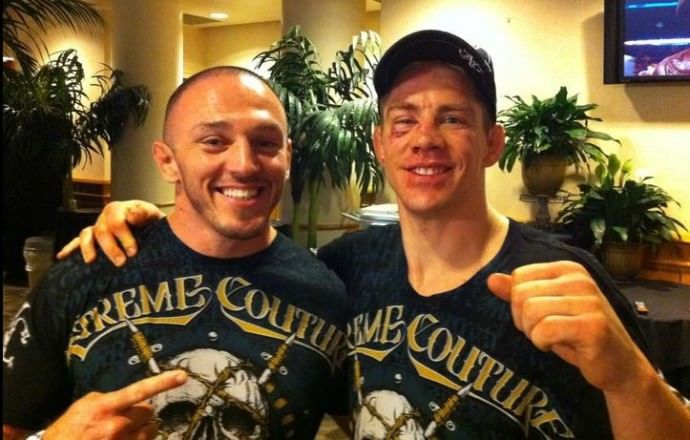
by Duane Finley, HeavyMMA.com
The fight between Amir Sadollah and Duane Ludwig was billed as a battle of Muay Thai practitioners. That’s exactly how it played out.
As the first fight on the televised portion of the UFC on Versus 5 card, Sadollah and Ludwig wasted no time getting down to business. A striker vs. striker match-up, there wasn’t a lot of expectation the action would hit the mat, and when they met in the center of the Octagon it was fireworks.
Ludwig, who is heralded for his one shot knockout power, came out swinging as Sadollah did his best to keep the distance early. After a quick flurry followed by a knee, the two fighters locked into the clinch but Ludwig was able to reverse and break free. They continued to fire on one another at every turn and midway through the round, a Ludwig left hook buckled Sadollah. While he continued to apply the pressure, Sadollah was able recover and make it out of the round.
In the second frame it was more of the same as they continued what was started in the first. Standing toe to toe both fighters traded leg kicks and combinations while refusing to give ground. Sadollah opened up with his trademark push kicks and after landing two hard shots to the body, Ludwig countered with a right hand. Both fighters continued to exchange at a rapid pace with Ludwig constantly getting the better of his opponent.
Going into the final frame and being down two rounds, Sadollah attempted to turn up the heat. After landing two hard body kicks he shot in for the takedown which was quickly stuffed by Ludwig. The action hit the fence where Ludwig was able to land knees before working free. Running out of time, Sadollah continued to throw everything he had in his arsenal but every combination thrown was answered with more accuracy and power from Ludwig. With half a minute remaining on the clock, Ludwig scored a takedown and the fight remained on the mat until the final bell sounded.
When the judge’s decision was announced Duane “Bang” Ludwig was awarded the unanimous decision (29-28, 29-28, 29-28). The win tonight in Milwaukee makes it two in a row for the UFC veteran.
WHAT'S REALLY IN YOUR MILK?
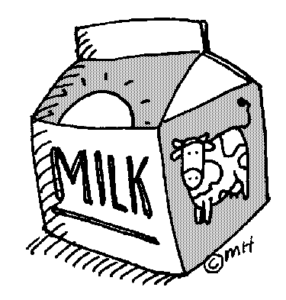 What’s Really In Your Milk?
What’s Really In Your Milk?
By: Dr. Joseph Mercola
Milk is thought of as a wholesome food, which is why so many parents give it to their children with every meal. And the truth is, it is wholesome when it’s in its raw form and sourced from cows fed non-contaminated grass and raised in clean conditions.
Unfortunately, the milk that winds up in most Americans’ glasses is far from this unadulterated state and, as the study above revealed, instead may be a veritable chemical cocktail.
What’s Really in Your Milk?
Spanish and Moroccan researchers used a highly sensitive test to determine what types of medications could be found in a variety of milk (cow, goat and human breast milk), and they hit the chemical jackpot. Medications used to treat diseases in both humans and animals were revealed. Among the drugs and hormones detected were:
Anti-inflammatories (niflumic acid, mefenamic acid, ketoprofen, diclofenac, phenylbutazone, naproxen, flunixin, diclofenac) Antibiotics (florfenicol) Natural hormones (estrone)
Sex hormones (17-beta-estradiol) Steroid hormones (17-alpha-ethinylestradiol) Anti-malaria drugs (pyrimethamine)
Anti-fungal drugs (triclosan)
While all types of milk tested contained chemicals, including breast milk, cow’s milk contained the highest levels. Some of these drugs and hormones were given to the cows directly, while others were likely ingested from the cattle food or contamination on the farm.
The truth is, chemical contaminants are now showing up throughout the entire food chain, which is why it’s so important to choose your food wisely, from farmers who make efforts to avoid toxins like these and certainly don’t add to the problem by supplying them directly. Unfortunately, if you buy your milk in most supermarkets, you can rest assured that it will probably contain contaminants you’d be better off avoiding.
Big Dairy Routinely Gives Drugs to Cows
It’s hard enough to raise pure food these days considering that environmental pollution is rampant, so finding pure water and soil can be a challenge. But in the case of big dairy, they are contributing to this pollution and taking no steps to ensure that their cows, or the milk they produce, are free from drugs and hormones. In fact, they readily feed these chemicals to the cows; it’s an integral part of the farming method on CAFOs (confined animal feeding operations).
For instance, did you know that every year U.S. inspectors find illegal levels of antibiotics in dairy cows? And that when the U.S. Food and Drug Administration (FDA) made plans to test milk from cows that had shown high levels of drug residues repeatedly, the dairy industry protested … and the FDA backed down and postponed the testing?
It’s true.
And now, instead of looking out for Americans’ health and taking action against what could be dangerously high levels of antibiotics in milk (not to mention contributing to the spread of antibiotic-resistant disease), they are planning to “confer with the industry before deciding how to proceed,” the New York Times reported. Dairy cows raised on CAFOs also eat grains that are heavily treated with chemicals that are transferred to the milk.
Do You Want Hormones With Your Milk?
There’s also the issue of recombinant (genetically engineered) bovine growth hormone (rBGH), which is used to significantly increase milk production in cows. Treated cows can produce as much as 15-25 percent more milk. But this increase in milk production, and hence profit, has hidden costs, namely the cows’ and your health.
For nearly two decades, the FDA has held on to their initial finding that there’s “no significant difference” between the milk of cows given genetically modified artificial growth hormone and those that aren’t. But the milk produced by these cows has been shown to be anything BUT identical to untreated milk.
Hormone-treated milk is different from non-treated milk because:
It contains increased levels of the hormone IGF-1, which promotes cancer tumors. According to Dr. Epstein, professor emeritus of Environmental and Occupational Medicine at the University of Illinois School of Public Health, and Chairman of the Cancer Prevention Coalition, excess levels of IGF-1 have been incriminated as major causes of breast, colon, and prostate cancers
Hormone use “induces an unnatural period of milk production during a cow’s “negative energy phase.” Milk produced during this stage is considered to be low quality due to its increased fat content and its decreased level of proteins, an Ohio court, which ruled that milk in Ohio can still bear an “rbGH-free” label, stated.
It contains increased somatic cell counts (SCC’s). This means the milk contains more pus, which makes it turn sour more quickly. Increased SCC count also affects the milk’s taste, smell, texture and color. Raised SCC levels is typically caused by the high incidence of mastitis in rBGH-injected cows
Further, Dr. Epstein has pointed out several additional differences between rBGH milk and untreated milk and all of these factors can cause or contribute to health problems:
Contamination of the milk by the GM hormone rBGH
Contamination of the milk with illegal antibiotics and drugs used to treat mastitis and other rBGH-induced disease
Increased concentration of the thyroid hormone enzyme thyroxin-5′-monodeiodinase
Increased concentration of long-chain and decreased concentration of short-chain fatty acids
A reduction in levels of the milk protein casein
Want Better Milk? This Option is Even Superior to Organic
You may be thinking that the solution to purer milk is to buy organic. Organic milk is clearly better as organic dairy cows will not be given rBGH or routine antibiotics … but it will still have been pasteurized, and this seriously compromises the quality of the milk.
A better option is grass-fed RAW milk, which is nearly always better than organic milk if it is purchased from a conscious farmer. In that case, it may not be certified organic, but it will essentially be organic anyway, and drinking your milk raw is the superior choice. Milk from grass-fed cows, unlike grain-fed cows, will be high in CLA that is loaded with many health benefits including helping you lose weight.
I typically have four tablespoons of raw grass-fed butter a day and that has 1,000 mg of CLA.. So if you are having the real whole food with the beneficial fat you do not need the supplement.
Pasteurization transforms the physical structure of the proteins in milk, such as casein, and alters the shape of the amino acid to one that your body is not equipped to handle. The process also destroys the beneficial bacteria typically found naturally in milk and drastically reduces the micronutrient and vitamin content.
Pasteurization also destroys part of the vitamin C in raw milk, encourages the growth of harmful bacteria, and turns milk’s naturally occurring sugar (lactose) into beta-lactose. Beta-lactose is rapidly absorbed in the human body, with the result that hunger can return quickly after a glass of milk — especially in children. The pasteurization process also makes insoluble most of the calcium found in raw milk. This can lead to a host of health problems in children, among them rickets and bad teeth. And then there’s the destruction of about 20 percent of the iodine available in raw milk, which can cause constipation.
When pasteurized milk is also homogenized, a substance known as xanthine oxidase is created. This compound can play a role in oxidative stress by acting as a free radical in your body.
Raw milk, on the other hand, contains good bacteria that are essential for a healthy digestive system, and offers protection against disease-causing bacteria … so I don’t recommend you waste a penny on pasteurized organic milk — seek out milk (and other dairy products) from a reputable raw dairy instead.
Tips for Finding High-Quality Raw Milk
The quality, purity and cleanliness of your milk is only as good as the farm it came from, which is why I want to explain how to identify high-quality sources of raw milk. Right now, only 10 states permit the retail sale of raw milk, and each state sets its own standards. California, specifically, has its own special set of standards for raw milk for human consumption, in which farmers must meet or exceed pasteurized milk standards, without pasteurizing.
Finding raw milk is NOT that hard and nearly everyone should be able to locate a supplier if you are persistent enough. You can find raw milk retailers in California by using the store locator available at www.OrganicPastures.com, and for other areas, check out the Campaign for Real Milk Web site. You can also look here to find out the legal status of raw milk in the U.S. state or country where you live.
Since many raw milk producers are very small farms, and the standards that do exist vary from state to state, how do you go about identifying solid, high-quality producers of raw milk if you can’t just buy it in a store nearby? There are a few general conditions you should look for, including:
Low pathogenic bacteria count (i.e. does the farmer test his milk regularly for pathogens?)
The milk is quickly chilled after milking
The milk comes from cows raised naturally, in accordance with the seasons
The cows are mainly grass-fed and well cared for
The cows are not given antibiotics and growth hormones to increase milk production
If you’re thinking about purchasing milk from a small farmer, it would be very wise to visit the farm in person. Look around and ask questions, such as:
Do the farmer and his family drink the milk themselves?
How long has he been producing raw milk?
Are the cows clean?
What conditions are the cows raised in?
Are there any obvious sanitation questions?
If a cow is covered in filth and manure, stinks, is wet and cold and doesn’t look particularly comfortable, that could be a warning sign that her milk is less than ideal for consumption, even if it’s from a small, local farm. Virtually all cows raised on CAFOs will be raised in these types of poor conditions, which is another reason I don’t recommend consuming milk that comes from these big dairy sources.
For more information, I suggest you to listen to my interview with Mark McAfee, the founder of Organic Pastures, one of the largest producers of raw milk in the United States and clearly, one of the leaders in this industry.
Mark McAfee’s experience and knowledge base on this topic is phenomenal, and the interview covers many of the facets involved in raising healthy cows and producing healthy raw milk, as well as the numerous health benefits, and potential pitfalls, of raw milk. Unfortunately, the U.S. Food and Drug Administration (FDA) is trying to shut down your right to choose to drink raw milk. You can learn more about this unconstitutional assault on one of your most basic rights here.
Originally story written for Mercola.com
Devin Cole Earns Strikeforce Unanimous Decision Victory
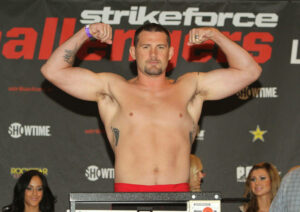
Two college wrestlers collided in an active three-round tilt made on three days’ notice. Late replacement Shawn Jordan was game but unable to match his more prepared opponent’s gas tank, and Devin Cole won the unanimous decision to get his 19th MMA win (with 9 losses, 1 draw). Video: Cole post-fight interview
The first round was competitive, with Cole using his reach advantage to paw at Jordan before being bulled into the cage by the larger heavyweight. A trip resulted in the men hitting the ground, with Jordan taking Cole’s back, but he was unable to sink a choke and the two scrambled back to their feet. Jordan caught a leg and punished Cole with sharp shots that landed square as the bell rang.
A standing exchange opened the second, and a knee connected with Jordan, who seemed to wake up from the blow. But Cole shot in and struggled for a takedown. For the rest of the second, Cole pressed Jordan against the cage, and the former LSU football player bent over with one hand on the ground to avoid blows to the head.

Jordan was exhausted by round three, but he gamely lumbered forward for several minutes of standing exchanges. Both men narrowly missed with powerful uppercuts, but back at the cage, Cole secured another takedown that ended with him in half-guard. Dominant elbows and hammerfists in the closing minute secured his UD win over Jordan, whose record now stands at 11-2. Scores for Cole were 30-27 twice and 29-28.
Photo & Story originally posted at Strikeforce.com
Devin Cole drops 25 lbs in 5 weeks prior to Strikeforce victory!
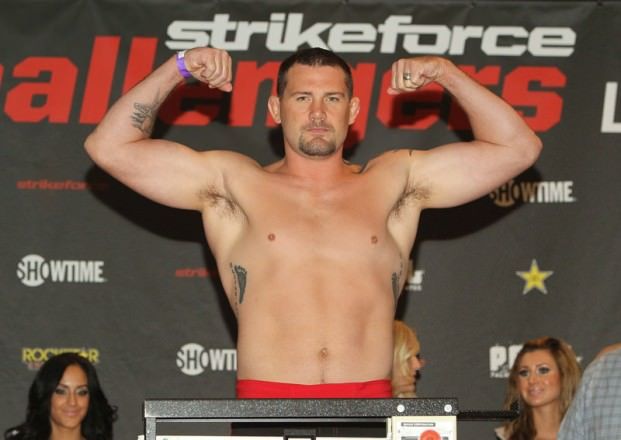
Devin Cole makes a successful return to the Strikeforce cage after dropping 25 lbs in just 5 weeks prior to his co-main event fight in Strikeforce, which was show live on Showtime cable television.
Cole weighed 263 lbs on Fathers Day, June 19, 2011 just before starting ‘The Dolce Diet’ and weighed 239 lbs on the official scale July 21, 2011.
YAHOO Sports: Mike Dolce Talks Peak Performance…

Working in MMA: Mike Dolce Talks About Peak Performance, Maury and Manicures
By Maggie Hendricks
 This week, Cagewriter is taking a look at the different jobs that help the MMA world turn. See part I of the series here.
This week, Cagewriter is taking a look at the different jobs that help the MMA world turn. See part I of the series here.
Today, we look at Mike Dolce, the peak performance coach who is known to help fighters improve their nutrition, and in turn, the way they fight. After working as a strength coach for 20 years and appearing on the seventh season of “The Ultimate Fighter,” Dolce has worked with fighters such as Quinton “Rampage” Jackson, Thiago Alves, Chris Leben and Vitor Belfort.
Cagewriter: What is your job like on a day-to-day basis?
Mike Dolce: I’m running multiple training camps from afar. Right now, in Vegas, I’m running Vitor Belfort’s training camp and Mike Pyle’s. I also have Thiago Alves coming up, and I’m his head coach. I cover so many hats with him, but Vitor and Pyle, I work specifically with their nutrition and weight management issues.
I say more peak performance coach because I do the meals, I do the weights, I do the overall training management. I’m the filter for the other coaches. I set up the training schedule from day to day. I even structure in their business meetings and social function as they get closer to fight time.
CW: Thiago, for example, you set his day?
MD: With Thiago, I literally set up his 24 hours, seven-day a week schedule. Which coach to go to, when he’s not allowed to train, because that can be a problem with him, so I have to pull him back a lot. I have to schedule in massage therapy or alternate therapies to make sure he’s not going to go to the gym.
On Sundays, I would schedule “Man-Day.” He and I would go have a nice breakfast, and then go to a spa. We’d get a haircut, massages, get our feet and hands fixed it, even the random facial. It’s important. I incorporate all those things to make sure my fighters are well-rounded.
I try to keep what I call “the positive bubble around fighters” and not let any negativity in. With Mike Pyle, I would get breakfast ready as he watched a fishing show on Versus, but now the Tour de France is on. It broke our rhythm, so instead of watching fishing, he switched to another channel with Maury and the Jerry Springer show. I’m in the kitchen, 20 feet away and I can feel the negative energy come out of the TV. I had to change the channel just to watch something more positive. You can’t start your day with that kind of negative mind frame.
CW: What is a fight week like for you?
MD: I try to get to town a day prior to the athlete, then I set up the hotel room and do the food shopping. For Chris Leben, he got into town on Monday night, and before he even got here, I packed a huge cooler with the proper foods that Chris was going to need. I made sure he had everything he was going to need, coordinate with his team, talk about what his weight cut process is going to be. On weigh-in day, I will be with him through the weigh-ins, and then go back to his room for the rehydration process. That carries all the way through to the minute he steps in the cage, performs, and then even afterwards, when I give him the food and fluids that need to go in his body to help him repair and recover from that. My job typically doesn’t end until Sunday morning.
CW: What is the best part of your job?
MD: The best part of my job is spreading health. My primary focus is not world titles, and it’s not money, or any of those things. It’s to make my athletes as healthy as possible. That’s the most rewarding part: seeing kids like Thiago Alves, not so much go out there and have a dominant performance, but it’s for him to feel so good and be so happy with himself because his body is in a positive state. Performance is just a by-product of that.
CW: But what’s the worst part?
MD: I wouldn’t point to a worst part and say that it’s bad, but the hardest part is dealing with the ups and the downs of the sport. You can work with an athlete, and have a great training camp and he’ll go out there on fight night, and something doesn’t work. I’m so emotionally attached to my fighters that it’s a hard roller coaster. For me, it’s multiple times in a single night.
Actually, the worst part is the time away from my family, but it’s a choice, but I’m not going to be a victim to it. It’s something we’ve decided over the next few years to do this.
Follow Mike Dolce on Twitter @TheDolceDiet.
Tomorrow’s working in MMA profile will focus on Bernie Profato, head of the Ohio Athletic Commission.
Original story posted on YAHOO.com
